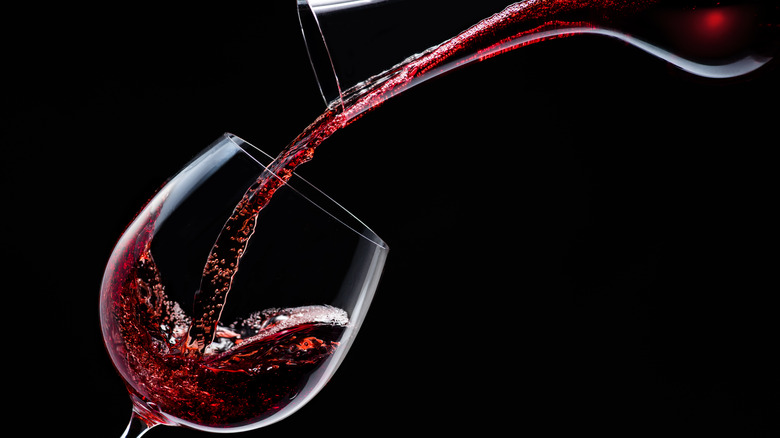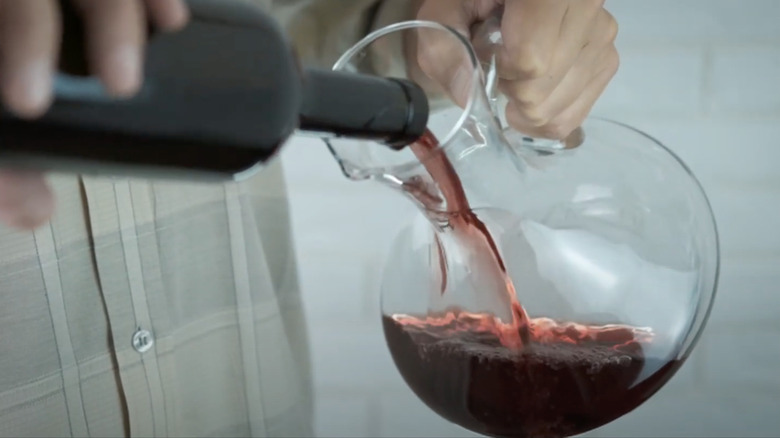The Best Way To Decant Wine Without A Decanter
A proper wine decanter does an important job and looks lovely while doing it. There are plenty of bell-bottomed or swan-shaped crystal vessels that are perfect for this purpose, but not everyone has one lying around. But that's not a deal breaker. At the end of the day, a decanter serves to introduce air into the wine and separate out unwanted sediment. You can actually achieve the exact same result by pouring the wine into any other glass vessel. An old water pitcher, carafe, or vase will work. You could even use pint glasses or large Mason jars in a pinch.
Treat your stand-in tool just as you would a regular decanter. The person serving the wine pours the liquid into the glass vessel and allows the stream to fan out along the inside walls on its way down. This increases how much surface area the wine is exposed to and, consequently, how much oxygen is introduced. As it sits, the wine continues to oxidize, or "open up." The pourer is also keeping an eye on any solid bits that have settled in the bottom of the wine bottle and stops pouring before those parts tip into the decanter, leaving behind sediment-free wine that has come to life from the air exposure.
The benefits of decanting wine
When you have a full-bodied or aged wine, it's important to decant it. Aside from the material benefit of avoiding a sandy sip, aerating will markedly improve the taste. When bottled, the aroma of wine becomes stifled. Since how something smells is a huge part of how humans experience taste, a wine that hasn't had the aromatic compounds activated may taste dull and flat. However, decanting unlocks those aromas, and as wine sits in the decanter and continues to breathe, the taste will also evolve. The process also softens the feel of bold tannins.
A resting period between 30 minutes to about an hour will do the trick, though too much oxygen exposure will cause the wine to go stale. It depends mostly on how full-bodied the libation is and how structured the tannins are. Wines that have grown delicate with age will need less time, while varietals with heft, such as Italian wine grapes like Nebbiolo or Montepulciano, will need more time.
An additional benefit of a decanter is how beautiful they are. You can serve wine straight from the vessel, which is useful for hosting a stress-free dinner party. Pouring wine from a jar doesn't create quite the same effect. However, you can actually utilize the bottle it came in. After decanting, rinse the wine bottle with water and allow it to drip dry upside down while the wine rests. Then, use a funnel to pour the decanted wine back in.
Aerators can (mostly) get the job done
Aerators are another alternative if you don't have a wine decanter — in some cases. Older wines really do need to be decanted because of the sediment that accumulates. In red wines, these particles come from old yeast, pieces of grapes, and polymers. While not unsafe to consume, they can definitely have an off-putting flavor and texture. White wines can occasionally form tiny, innocuous, crystals or be bottled with residual yeast, too, so these varietals also benefit from having the sediment decanted out.
However, young wines don't typically have a lot of sediment. If they are highly tannic and rich, they definitely need some aeration, but probably don't need a gentle hand and watchful eye monitoring for grit. Aeration devices can come in the form of a bottle topper or a device that is held above the glass. As you pour, the wine is forced to go through a series of tubes, chambers, or holes to expose it to oxygen much more quickly than traditional decanting. The very best aerators will actually include a filter component that can catch any stray sediment or broken cork pieces. If you are an avid wine drinker, one of these high-tech options may be a great tool to have at your disposal.



